| Srl | Item |
| 1 |
ID:
129938
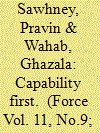

|
|
|
| 2 |
ID:
017676
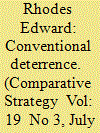

|
|
|
|
|
| Publication |
July-Sept 2000.
|
| Description |
221-254
|
|
|
|
|
|
|
|
|
|
|
|
|
|
|
|
| 3 |
ID:
112452
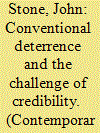

|
|
|
|
|
| Publication |
2012.
|
| Summary/Abstract |
The concept of 'credibility' is a central component of deterrence theory. In this article, credibility is used as a lens through which to examine the effectiveness of conventional force as a deterrent. An advantage that conventional force enjoys over its nuclear counterpart is that it can be used with much greater discrimination. Conventional threats can, therefore, be considered more politically credible than nuclear threats under all but the most extreme circumstances. Conversely, the relatively modest power of conventional weapons renders their effects 'interpretable' to a problematic degree by potential aggressors. Thus, such threats are less likely to be as technically credible as their nuclear equivalents. A range of communicative efforts may serve to reduce the scope for interpreting the effects possible to conventional weapons, although efforts of this kind risk being hampered by cultural obstacles. In consequence, success with conventional deterrence will turn on the ability to identify the specific technical and cultural conditions under which credible threats can readily be made.
|
|
|
|
|
|
|
|
|
|
|
|
|
|
|
|
| 4 |
ID:
092366
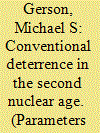

|
|
|
| 5 |
ID:
132280


|
|
|
|
|
| Publication |
2014.
|
| Summary/Abstract |
The use of conventional armed forces in a deterrent role merits close consideration. Instability in weak or failing states can have global ramifications, while efforts to build stability take time. In principle, conventional deterrence can be used to buy the time required for such stabilization efforts. Attempts at deterrence will, however, need to overcome credibility problems stemming from the technical limitations associated with conventional armed forces, and with the likely requirement for multiple external actors to deter multiple intrastate audiences. While deterrence might work under certain circumstances, it will not play as central a role in strategy as it did during the Cold War.
|
|
|
|
|
|
|
|
|
|
|
|
|
|
|
|
| 6 |
ID:
170577
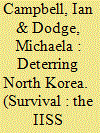

|
|
|
|
|
| Summary/Abstract |
If conventional deterrence fails, the US must be able to terminate war on favourable terms.
|
|
|
|
|
|
|
|
|
|
|
|
|
|
|
|
| 7 |
ID:
013658
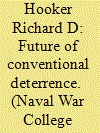

|
|
|
|
|
| Publication |
Summer 1992.
|
| Description |
78-88
|
|
|
|
|
|
|
|
|
|
|
|
|
|
|
|
| 8 |
ID:
142648
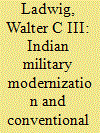

|
|
|
|
|
| Summary/Abstract |
In recent years, headline grabbing increases in the Indian defense budget have raised concerns that India’s on-going military modernization threatens to upset the delicate conventional military balance vis-à-vis Pakistan. Such an eventuality is taken as justification for Islamabad’s pursuit of tactical-nuclear weapons and other actions that have worrisome implications for strategic stability on the subcontinent. This article examines the prospects for Pakistan’s conventional deterrence in the near to medium term, and concludes that it is much better than the pessimists allege. A host of factors, including terrain, the favorable deployment of Pakistani forces, and a lack of strategic surprise in the most likely conflict scenarios, will mitigate whatever advantages India may be gaining through military modernization. Despite a growing technological edge in some areas, Indian policymakers cannot be confident that even a limited resort to military force would achieve a rapid result, which is an essential pre-condition for deterrence failure.
|
|
|
|
|
|
|
|
|
|
|
|
|
|
|
|
| 9 |
ID:
030381
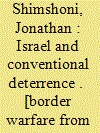

|
|
|
|
|
| Publication |
Ithaca, Cornell University Press, 1988.
|
| Description |
xii, 247p.hbk
|
| Series |
Cornell Studies in Security Affairs
|
| Standard Number |
0801421209
|
|
|
|
|
|
|
|
|
|
|
|
Copies: C:1/I:0,R:0,Q:0
Circulation
| Accession# | Call# | Current Location | Status | Policy | Location |
| 030217 | 956.9405/SHI 030217 | Main | On Shelf | General | |
|
|
|
|
| 10 |
ID:
138672
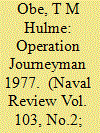

|
|
|
|
|
| Summary/Abstract |
In this series, the author tackles an important but often neglected and misunderstood subject, that of conventional deterrence.
|
|
|
|
|
|
|
|
|
|
|
|
|
|
|
|
| 11 |
ID:
156477
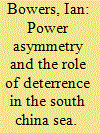

|
|
|
|
|
| Summary/Abstract |
China’s coercive activities in the South China Sea have resulted in a lively
academic debate regarding strategies to deter Beijing and maintain the status quo.
However, much of this literature has been dominated by the U.S.–China dynamic
and has neglected the vital role of the littoral states in the region. This article,
through the lens of a maritime strategic environment, deals with the potential for the
littoral nations of the South China Sea to deter China. It argues that conventional
deterrence by denial is a difficult but applicable strategy despite the substantial
power asymmetry that exists between China and the littoral states in the region.
However, such a deterrent approach must be tailored to the specific, non-existential
challenges that China poses in the region. Among these challenges, this article
examines deterrence within the context of China’s claim to the Spratly Islands and
expansive claims to economic exploitation rights. A maritime strategic environment
provides multiple avenues to impose cost on a superior power and the littoral states
in the region have invested heavily in naval capabilities. However, as this article
finds, it remains to be seen if the littoral states in the region have the technical
capability or political will to successfully enact such a deterrent strategy.
|
|
|
|
|
|
|
|
|
|
|
|
|
|
|
|
| 12 |
ID:
001627


|
|
|
|
|
| Publication |
London, Johns Hopkins University, 1985.
|
| Description |
xx, 270p.
|
| Standard Number |
0801838428
|
|
|
|
|
|
|
|
|
|
|
|
Copies: C:1/I:0,R:0,Q:0
Circulation
| Accession# | Call# | Current Location | Status | Policy | Location |
| 041229 | 355.0217/JER 041229 | Main | On Shelf | General | |
|
|
|
|
| 13 |
ID:
130286
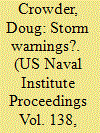

|
|
|
| 14 |
ID:
142977
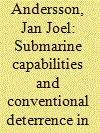

|
|
|
|
|
| Summary/Abstract |
Submarines are often described as a weapon of choice for the weak to deter the strong. There are today a growing number of countries operating submarines in Southeast Asia, but just how capable are they? Unable to match the large multi-mission navies of countries such as China, India or Japan, many of the smaller economies in Southeast Asia have invested in conventional submarines to deter their neighbours. This article draws on deterrence theory to analyse the significance of submarine proliferation in Southeast Asia on the strategic balance in the region. It systematically examines submarine maintenance and training issues and concludes that the challenges involved in building up and maintaining a submarine force are far greater than is commonly understood or acknowledged. The evidence presented in this article suggests that few countries in the region currently have the capability and strategy to convincingly make the case that their submarine force by themselves could be an effective deterrent. Although the proliferation of submarines in Southeast Asia may suggests a changing strategic balance in the region, the findings of this study underscore the dangers of conflating acquisition of equipment with capabilities in practice.
|
|
|
|
|
|
|
|
|
|
|
|
|
|
|
|